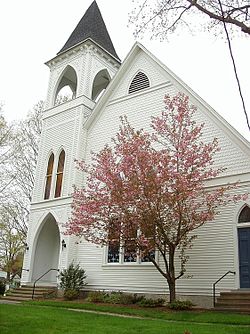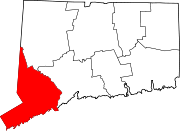Huntington Center Historic District
Huntington Center Historic District | |
 Huntington Congregational Church | |
| Location | Roughly along Church and Huntington Sts., from Ripton Rd. to the Farmill River, Shelton, Connecticut |
|---|---|
| Coordinates | 41°17′29″N 73°8′39″W / 41.29139°N 73.14417°W |
| Area | 60 acres (24 ha) |
| Architectural style | Colonial, Federal |
| NRHP reference No. | 00000296[1] |
| Added to NRHP | March 31, 2000 |
The Huntington Center Historic District is a historic district in the city of Shelton, Connecticut. The district encompasses the original colonial settlement of Shelton, which was first known as Huntington. It is a linear district about 0.75 miles (1.21 km) in length, centered on the Huntington Green and Cemetery, and extending north along Church Street and south along Huntington Street. The district is predominantly residential, although it has two churches. The green was laid out in 1717, and many of the district's historic buildings were built over the next 150 years. The district's oldest building is a house with an estimated construction date of 1710.[2] The district was listed on the National Register of Historic Places in 2000.[1]
The area that is now Shelton was settled by English colonists in the 17th century as part of Stratford. In 1717 a Congregationalist parish was established, and in 1789 the town of Huntington was incorporated, including what is now neighboring Monroe. The site of the early parish became the center of the new town. In addition to its civic function, the area also developed some industry, powered by the waters of the Farmill River and Means Brook. In the second half of the 19th century, the community's industrial and civic focus shifted to the Housatonic River (its eastern border), and it was renamed Shelton in 1919 in honor of Edward Shelton, one of its major industrialists. Shelton's likely ancestral home still stands in Huntington Center.[2]
Significant properties
[edit]- Huntington Green, 1717
- Josiah Wheeler House
- DeForest-Rudd House, c. 1770, Colonial
- Huntington Congregational Church, c. 1890, Gothic Revival
- St. Paul's Episcopal Church, 1812, Federal
See also
[edit]References
[edit]- ^ a b "National Register Information System". National Register of Historic Places. National Park Service. March 13, 2009.
- ^ a b Jan Cunningham (September 20, 1998). "National Register of Historic Places Inventory-Nomination: Huntington Center Historic District". National Park Service. and Accompanying 18 photos, from 1998 (captions on p. 20 of text document)



